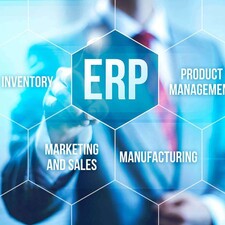Blog
Augmented reality at a glance: What does the future hold for your business?

Summary
Businesses everywhere are putting their money on augmented reality technology. A MarketsandMarkets report predicts the AR industry will maintain a compound annual growth rate of more than 75 percent over the next six years to reach nearly $120 billion in 2022.
What spurred this meteoric rise? To business leaders, the future of AR represents a remarkable leap forward in production and service capabilities.
What is augmented reality?
Essentially, AR technology superimposes data onto real-world environments. However, AR doesn't merely overlap one over the other - it creates a channel through which both the virtual and the physical interact.

Augmented reality: Real-time data in the blink of an eye
Demonstrating AR value to customers
So, what does augmented reality look like in practice?
AR industry will maintain a compound annual growth rate of more than 75 percent over the next six years to reach nearly $120 billion in 2022.
Imagine you worked as a sales representative at a manufacturing plant and your company produced large-scale industrial-grade textile looms. With AR, you could construct and transmit virtual representations of your customers' orders before assembly ever takes place. Because these 3-D models of their commissioned builds would be to specification, customers can accurately visualize how their equipment would fit into their production lines using their own AR equipment.
The results: Businesses expedite their sales processes and bolster customer service by demonstrating exactly what the customer will receive. If the product's dimensions are too big or its moving parts are obstructed, changes can be applied at a moment's notice. That's lightspeed when you consider traditional quoting processes. Moreover, customers also get a boost of buying confidence seeing their future investment in action.
Demonstrating AR value internally
What about on-site applications? As equipment in industrial sectors evolve, upgrade and advance operators will require more extensive training, which costs their employers considerably in productivity. Operators tapped into AR, however, can receive real-time training on the actual machinery they'll use every working day. That means no manuals to refer back to, no co-workers to distract with minor questions and practically no learning curve.
Even seasoned operators can benefit from AR. With a mainline to real-time demand, workers always know exactly how to adjust equipment to retain resources and reduce waste.
Additionally, the implications for asset maintenance are limitless. Because industrial enterprises continue to utilize sensor technology to evaluate equipment performance, maintenance professionals with AR technology need only look at equipment to uncover operational deficiencies instead of peeking under the hood. This application alone saves countless hours of labor and optimizes proactive maintenance cost-to-value ratios.
For consummate AR experiences, adopters need high-functioning ERP
Excited as business leaders and tech junkies might be at the prospect of partial-immersion AR, let's not put the cart before the horse. Before AR can deliver on all these promises and more, companies must have an end-to-end data management strategy powered by innovative enterprise resource planning solutions.
AR technology not only runs on data - it depends on a fully integrated data depository capable of collecting information from disparate sources, not to mention any information gathered by the AR technology itself for use elsewhere in a company. ERP software, in essence, is the backbone supporting not only AR technology but all other end-user devices composing the next generation of industry.
If you have any questions, please feel free to contact one of our abas representatives today! Also be sure to download our free e-book: Unbounded Manufacturing, for even more ERP benefits.


